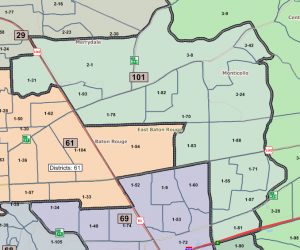District Map
Voting History
| 2008 President | ||
| Current District | New District | |
| John McCain (R) | 294 (3%) | 5128 (30%) |
| Barack Obama (D) | 9144 (97%) | 11994 (69%) |
| Others | 34 (0%) | 140 (1%) |
| 2008 Senate | ||
| Current District | New District | |
| Mary Landrieu (D) | 277 (96%) | 4055 (75%) |
| John Kennedy (R) | 8825 (3%) | 12652 (24%) |
| Others | 93 (1%) | 200 (1%) |
| 2010 Senate | ||
| Current District | New District | |
| David Vitter (R) | 185 (3%) | 3230 (30%) |
| Charlie Melancon (D) | 5506 (93%) | 7099 (66%) |
| Others | 250 (4%) | 508 (5%) |
| 2010 Lt Governor | ||
| Current District | New District | |
| Jay Dardenne (R) | 305 (5%) | 3855 (36%) |
| Caroline Fayard (D) | 5654 (95%) | 6963 (64%) |
Current District
House District 101 was located in New Orleans East in an area bounded roughly by the Industrial Canal, Lower 9th Ward, Paris Road, Chef Menteur Highway, Crowder Road, and Lake Pontchartrain. It has the most substantial black voting majority (92%, up from 86% several years ago) of any Louisiana House district. While it routinely turns in near unanimous Democratic percentages, it’s worth noticing that when Bobby Jindal first ran for governor in 2003, the endorsement of former mayor Ray Nagin enabled Bobby to get 21% of the vote here. Without Nagin’s endorsement in 2007, Jindal’s share of the district vote slipped to 14%.
The district’s legislative representation has been fairly steady, with black Democratic representation for years. Democrat Naomi White Warren (later Farve) represented the area from 1986 to 1999. She received fairly strenuous competition each time she ran, and her re-election percentages were consistently in the 60-67% range. When she retired, Cedric Richmond was elected with 63% of the vote in the 1999 primary, then was easily re-elected in 2003 and 2007. Though he would have been term limited this year, he recently vacated the district after his successful election to Congress last year.
Proposed District
Population losses in Orleans and Jefferson Parish made redistricting a tricky proposition for the area: the district ended up having 42% less population than needed for a state representative district after the 2010 Census. Combine that with the resignation of Cedric Richmond (he was succeeded in a special election by Wesley Bishop, who clinched the election in the first primary with 75%) and you had a district that was an obvious candidate for elimination. The 70% of the district west of Crowder Boulevard was added to Charmaine Stiaes’ Lower 9th Ward district. The remainder was added to Austin Badon’s New Orleans East district.
The new district has been relocated to East Baton Rouge Parish in a section that has seen fairly rapid demographic change in recent years – precincts that in 2003 had 46% black voter registration are now 63% black. The district was drawn by taking portions of District 29 (the district of Regina Barrow, which is 47% of the new district), District 66 (Hunter Greene’s old district, which makes up 35% of the new district), District 65 (Clif Richardson’s district, which is 10% of the new district), and District 61 (Michael Jackson’s district, which is 7% of the new district).
The district itself is fairly compact and can be described as follows: the northernmost end of the district is in the Brookstown area. From there, the district includes black middle class neighborhoods of Monticello and Park Forest along Greenwell Springs Road. District 101 then travels down Sherwood Forest Boulevard to pick up the neighborhoods of Red Oak, Bellaire, and a portion of Sherwood Forest between Sherwood Forest and Flannery. The district then ends at I-12, where it picks up apartment complexes between Old Hammond Highway and I-12.
The 63% black voter registration majority makes this district likely to elect a Democrat, although a victorious candidate will need to draw sufficient support from the bloc of white middle class voters living in Sherwood Forest, Red Oak, and (to a lesser extent) Park Forest.


[…] District Map: Continue reading at http://new.winwithjmc.com/archives/2703 […]
Websites You Should Visit…
[…]very few websites that happen to be detailed below, from our point of view are undoubtedly well worth checking out[…]…
Websites you should visit…
[…]below you’ll find the link to some sites that we think you should visit[…]……
Related……
[…]just beneath, are numerous totally not related sites to ours, however, they are surely worth going over[…]……
Visitor recommendations…
[…]one of our visitors recently recommended the following website[…]……
Siesta Key Vacations…
[…]just underneath, are a list of totally unrelated web sites to ours, however, they are definitely worth checking out[…]…
Cool sites…
[…]we came across a cool site that you might enjoy. Take a look if you want[…]……
Great website…
[…]we like to honor many other internet sites on the web, even if they aren’t linked to us, by linking to them. Under are some webpages worth checking out[…]……
Sites we Like…
[…] Every once in a while we choose blogs that we read. Listed below are the latest sites that we choose […]…
Websites we think you should visit…
[…]although websites we backlink to below are considerably not related to ours, we feel they are actually worth a go through, so have a look[…]……
Websites you should visit…
[…]below you’ll find the link to some sites that we think you should visit[…]……